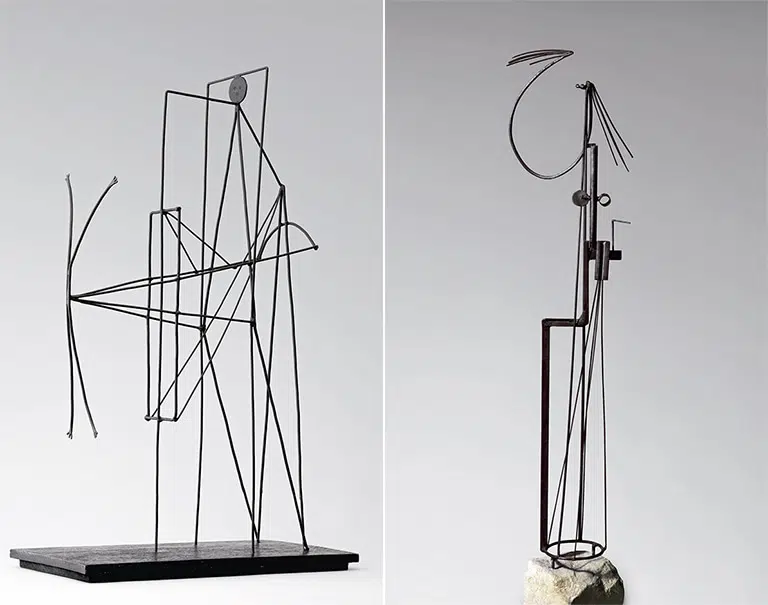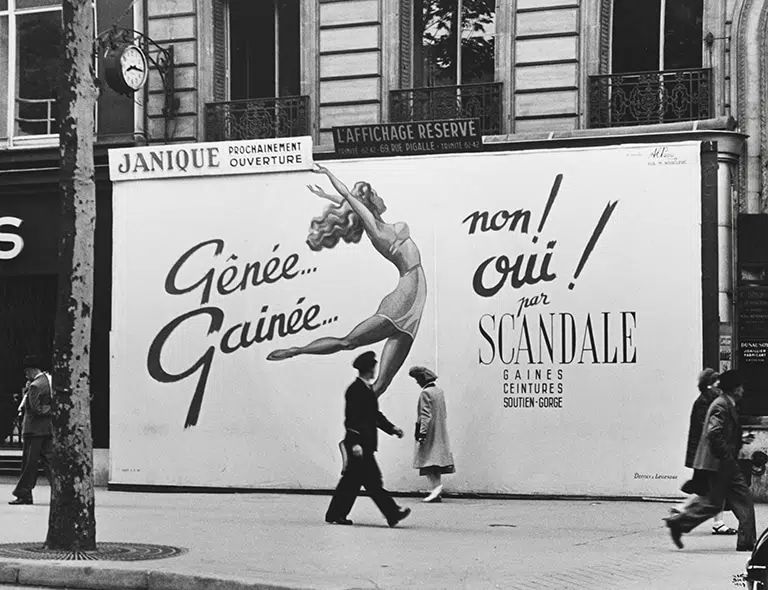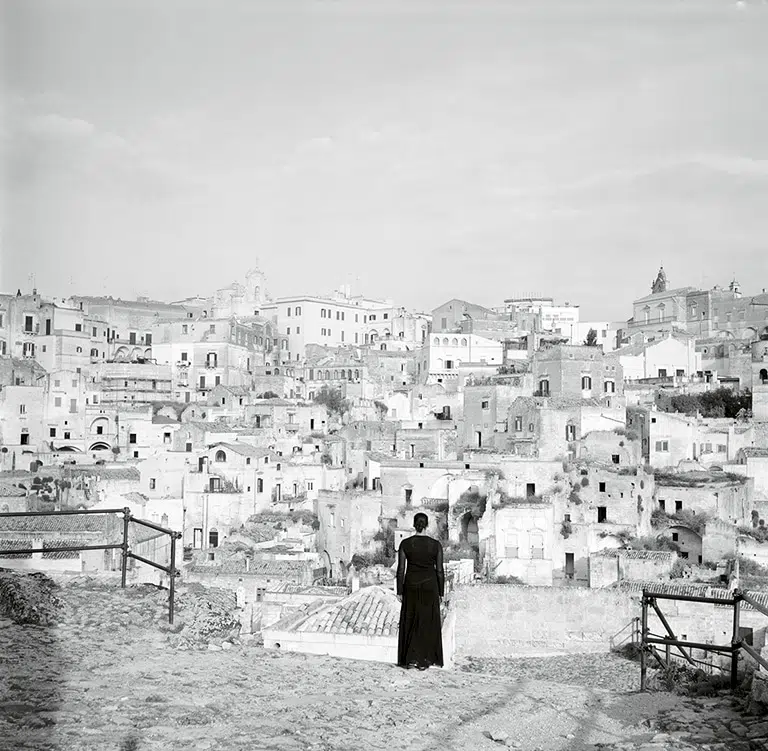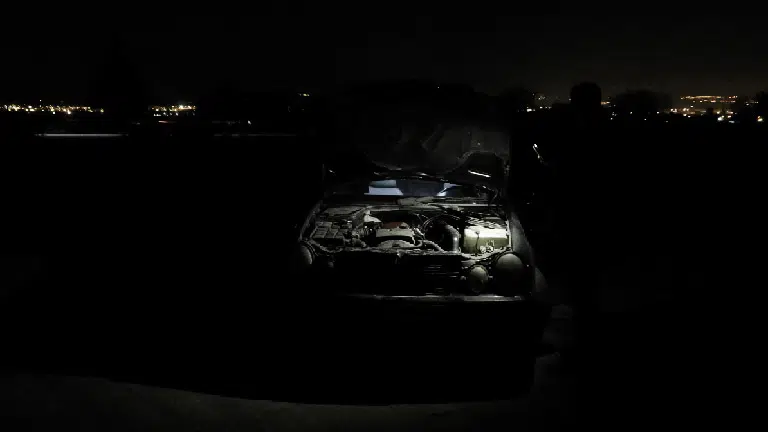Blind Woman, New York
![Blind Woman, New York [Mujer ciega, Nueva York] Blind Woman, New York [Mujer ciega, Nueva York] © Aperture Foundation, Inc., Paul Strand Archive © COLECCIONES Fundación MAPFRE](/media/arte-cultura/colecciones/paul-strand/FM000886.jpg)
Paul Strand
Blind Woman, New York, 1916
Camerawork and Nature Forms
© Aperture Foundation, Inc., Paul Strand Archive, 2021
© Fundación MAPFRE COLLECTIONS
Technique
Gelatin silver
Measurements
Measurement including margins: 32,7 × 25,1 cm
Paper size: 35,1 x 28,2 cm (13 13/16 x 11 1/8 in.)
Inventory
FM000886
Description
Paul Strand used the camera like a chisel. As if he were a sculptor of images, Strand observes and cuts, isolates and dignifies what he chooses to file in his memory. His curiosity led him to start photographing landscapes.He wanted to photograph people without being seen, and to do this he had to invent certain devices, drawing his subjects’ attention away and concealing his camera, as Walker Evans would later do. In this way, his focus shifted from the streets of New York to the inanimate object in his viewfinder that was dignified despite its being commonplace, from images of far off places like Ghana to photographs of plants and trees in his later years in which his garden in Orgeval became a cosmos.
There are works by Strand that form part of the collective imagination and have influenced and left their mark on how we perceive reality. With Blind (1915) and The White Fence (1917), he left the softness of the Photo secession style behind and began to explore a more sober and austere way of observing the world. Blind presents a reality of New York at the time, in addition to playing with the irony of the ability to see and not to see with the external observer. The White Fence is a fence: houses in the background, what appears to be a garden but perhaps is just a shape, almost abstract.
Paul Strand books and portfolios (in chronological order)
Photographs of Mexico. New York: Virginia Stevens, 1940.
Time in New England. Texts selected by Nancy Newhall. New York: Oxford University Press, 1950.
La France de profil. Text by Claude Roy. Lausanne: Guilde du livre, 1952.
Un Paese: Portrait of an Italian Village. Text by Cesare Zavattini. Turin: Giulio Einaudi, 1955.
Tir a’Mhurain: Outer Hebrides. Text by Basil Davidson. London: MacGibbon and Kee, 1962.
The Mexican Portfolio. 2nd ed. New York: Da Capo Press, 1967.
Living Egypt. Text by James Aldridge. New York: Horizon Press, 1969.
The Garden: A Portfolio of Six Original Photographs. New York: Michael E. Hoffman, 1976.
Ghana: An African Portrait. Text by Basil Davidson. Millerton, NY: Aperture, 1976.
On My Doorstep: A Portfolio of Eleven Photographs, 1914–1973. New York: Michael E. Hoffman, 1976.
Essays, articles and magazines about Paul Strand (in chronological order)
Photography. Seven Arts 2 (August 1917), pp. 524–25.
What Was 291? Unpublished manuscript, October 1917. Alfred Stieglitz / Georgia O’Keeffe Archive, Yale Collection of American Literature, Beinecke Rare Book and Manuscript Library, Yale University, New Haven, Connecticut.
The Eighth Art. Unpublished manuscript, 1917. Paul Strand Collection at the Center for Creative Photography, University of Arizona, Tucson.
Aesthetic Criteria. The Freeman 2 (January 12, 1921), pp. 426–27.
The Subjective Method. The Freeman 2 (February 2, 1921), p. 498.
Alfred Stieglitz and a Machine. New York: privately printed, February 14, 1921. [Reprinted in MSS 2 (March 1922), pp. 6–7. Reprinted in revised form in America and Alfred Stieglitz: A Collective Portrait, ed. Waldo Frank et al., pp. 281–85. Garden City, NY: Doubleday, Doran, 1934.]
‘The Independents’ in Theory and Practice. The Freeman 3 (April 6, 1921), p. 90.
American Water Colors at the Brooklyn Museum. The Arts 2, no. 3 (December 1921), pp. 148–52.
John Marin. Art Review 1, no. 4 (January 1922), pp. 22–23.
The Forum. The Arts 2, no. 5 (February 1922), pp. 332–33.
Photography and the New God. Broom 3, no. 4 (November 1922), pp. 252–58.
News of Exhibits: Sometimes a Week Elapses before Criticisms Are Published. Letter to the editor. New York Sun, January 31, 1923. [Also printed in the New York Herald Tribune, January 31, 1923, and New York World, February 11, 1923.]
Turrell, Henry, and Paul Strand. “Exhibitions and Other Things.” New York World, February 11, 1923.
The New Art of Colour. Letter to the editor. The Freeman 7 (April 18, 1923), p. 137. [In response to Willard Huntington Wright, “A New Art Medium.” The Freeman 6 (December 6, 1922), pp. 303–4.]
Photographers Criticized. Letter to the editor. New York Sun and Globe, June 27, 1923. [In response to Arthur Boughton, “Photography as an Art: Photographers Themselves Do Not Appreciate Its Possibilities. New York Sun and Globe, June 20, 1923.]
The Art Motive in Photography. British Journal of Photography 70 (October 5, 1923), pp. 612–15. [Adapted from an address delivered at the Clarence White School of Photography, New York, 1923. A précis of the text and note of discussion appeared in “The Art Motive in Photography: A Discussion.” Photographic Journal 64 (March 1924), pp. 129–32.]
Georgia O’Keeffe. Playboy: A Portfolio of Art and Satire, no. 9 (July 1924), pp. 16–20.
Marin Not an Escapist. New Republic, July 25, 1928, pp. 254–55.
Photographs of Lachaise Sculpture. Creative Art 3 (August 1928), pp. 23–28. [Reprinted as “Lachaise” in The Second American Caravan: A Yearbook of American Literature, ed. A. Kreymborg et al., pp. 650–58. New York: Macaulay, 1928.]
Steichen and Commercial Art. New Republic, February 19, 1930, p. 21.
A Picture Book for Elders. Review of David Octavius Hill by Heinrich Schwarz. Saturday Review of Literature 8, no. 21 (December 12, 1931), p. 372.
Note on Cine, July 1, 1933. Unpublished manuscript, Elizabeth McCausland Papers, Archives of American Art, Smithsonian Institution, Washington, DC.
Al margen de la temporada musical. Excelsior, July 12, 1933.
El significado de la pintura infantil. In Pinturas y dibujos de los Centros Culturales. Exh. cat. Mexico City: Dirección General de Acción Cívica, 1933.
Correspondence: ‘Paradise Lost.’ Letter to the editor. The Nation, January 15, 1936, p. 72.
The Fishermen of Vera Cruz: Stills from ‘Redes’—A Film. Daily Worker Sunday Worker, May 10, 1936.
Correspondence on Aragon. Letter to the editor. Art Front 3 (February 1937), p. 18. [In response to Louis Aragon, “Painting and Reality.” Art Front 3 (January 1937), pp. 7–11.]
Mr. Mellon’s Trustees. New Republic, March 31, 1937, p. 242.
The Photographs of Julio de la Fuente. In Photographs of Mexican Life from Negatives of Julio de la Fuente. Exh. cat. New York: New School for Social Research, 1937.
Les maisons de la misère. Films 1 (November 1939), pp. 89–90.
A Statement on Exhibition Policy. In Photographs of People by Morris Engel. Exh. cat. New York: New School for Social Research, 1939. [Reprinted as “Engel’s One Man Show.” Photo Notes, December 1939, p. 2.]
Review of An American Exodus by Dorothea Lange and Paul S. Taylor. Photo Notes, March–April 1940, pp. 2–3.
How I Feel about the War. New Masses, July 29, 1941, p. 16.
A Photographer Talks about War Films. Daily Worker, June 20, 1942.
A People’s Art in a People’s War. Undated typescript (c. 1942–45), Paul Strand Collection at the Center for Creative Photography, University of Arizona, Tucson.
Photography and the Other Arts. Unpublished manuscript, from a talk delivered on April 19, 1944, at the Museum of Modern Art, New York. Department of Photography Archives, Museum of Modern Art, New York.
Photography to Me. Minicam Photography 8 (May 1945), pp. 42–47.
Weegee Gives Journalism a Shot for Creative Photography. PM, July 22, 1945, pp. 13–14.
Alfred Stieglitz: 1864–1946. New Masses, August 6, 1946, pp. 6–7.
Stieglitz: An Appraisal. Popular Photography 21 (July 1947), pp. 62, 88–98. [Reprinted in Photo Notes, July 1947, pp. 7–11.]
Address by Paul Strand. Photo Notes, January 1948, pp. 1–3.
A Platform for Artists. Photo Notes, Fall 1948, pp. 14–15.
Paul Strand Writes to a Young Photographer.” Photo Notes, Fall 1948, pp. 14–15.
Realism: A Personal View. Sight and Sound 18 (January 1950), pp. 23–26. [Adapted from a lecture delivered at the International Congress of Cinema, Perugia, Italy, September 24–27, 1949. Reprinted as “International Congress of Cinema, Perugia.” Photo Notes, Spring 1950, 8–11, 18.]
Europe’s Films and Film Makers. Film Sense, February 1950.
Photographs of Walter Rosenblum. Exh. cat. Brooklyn, NY: Brooklyn Museum, 1950.
A Pattern of Islands. Picture Post, January 2, 1955, pp. 41–50.
How Creative Is Color Photography? In Popular Photography Color Annual, ed. Bruce Downes. Chicago: Ziff-Davis, 1957.
Painting and Photography.” Letter to the editor. Photographic Journal 103 (July 1963), p. 216. [In response to John Berger’s “Painting—or Photography?” Observer Weekend Review, February 24, 1963, p. 25.]
Manuel Alvarez Bravo. Aperture 13, no. 4 (1968), pp. 2–9.
Surprise of the Nile. Letter to the editor. Village Voice, October 9, 1969. [In response to review of Living Egypt by A. D. Coleman, August 21, 1969.]
The Snapshot. Aperture 19, no. 1 (1973), pp. 46–49.
Appreciation. In James N. Wood, Milton Rogovin: Lower West Side, Buffalo, New York, p. 3. Exh. cat. Buffalo, NY: Albright-Knox Art Gallery, 1975.
Monographs and catalogs of individual exhibitions (in alphabetical order)
Busselle, Rebecca, and Trudy Wilner Stack. Paul Strand, Southwest. New York: Aperture, 2004.
Claass, Arnaud. Paul Strand. Photo Poche 131. Arles, France: Actes Sud, 2011.
Denton, Susan. Paul Strand Archive. Guide series, no. 2. Tucson: Center for Creative Photography, University of Arizona, 1980.
Fleischmann, Kaspar. Paul Strand. Exh. cat. Zurich: Galerie zur Stockeregg, 1987.
Gerald Peters Gallery. Paul Strand: An Extraordinary Vision. Exh. cat. Santa Fe, NM: Gerald Peters Gallery, 1994.
Greenough, Sarah. Paul Strand: An American Vision. Exh. cat. Washington, DC: National Gallery of Art in association with Aperture, 1990.
Hambourg, Maria Morris. Paul Strand, circa 1916. Exh. cat. New York: Metropolitan Museum of Art, 1998.
Haworth-Booth, Mark. Paul Strand. Aperture Masters of Photography, no. 1. New York: Aperture, 1987.
Hirschl & Adler Galleries. Paul Strand: Photographs, 1910–1974. Exh. cat. New York: Hirschl & Adler Galleries in association with Weston Gallery, 1981.
Jareckie, Stephen B. Photographs by Paul Strand. Exh. cat. Worcester, MA: Worcester Art Museum, 1967.
Krippner, James, et al. Paul Strand in Mexico. Exh. cat. Mexico City: Fundación Televisa; New York: Aperture, 2010.
Lachaise, Gaston. Paul Strand, New Photographs. Exh. cat. New York: Intimate Gallery, 1929.
Llano, Rafael. Paul Strand: En el principio fue Manhattan = First There Was Manhattan. Exh. cat. La Coruña, Spain: Fundación Pedro Barrié de la Maza, 2008.
Lyden, Anne M. Paul Strand: Photographs from the J. Paul Getty Museum. Los Angeles: J. Paul Getty Museum, 2005.
McCausland, Elizabeth. Paul Strand. Springfield, MA: privately printed, 1933.
Museum of Fine Arts, Museum of New Mexico. The Transition Years: Paul Strand in New Mexico. Exh. cat. Santa Fe: Museum of Fine Arts, Museum of New Mexico, 1989.
National Portrait Gallery, London. Paul Strand: A Retrospective Exhibition of His Photographs, 1915–68. Exh. cat. London: National Portrait Gallery, 1976.
Newhall, Nancy. Paul Strand: Photographs, 1915–1945. Exh. cat. New York: Museum of Modern Art, 1945.
Paul Strand: A Retrospective Monograph, the Years 1915–1968. Exh. cat., 2 vols. Millerton, NY: Aperture, 1971. [A single-volume edition of the catalogue was published concurrently by the Philadelphia Museum of Art.]
Robert Miller Gallery. Paul Strand, Rebecca. Exh. cat. New York: Robert Miller Gallery, 1996.
Rocha, Regina Maurício da. A poética fotográfica de Paul Strand. São Paulo: Editora da Universidade de São Paulo, 2012.
Rosenblum, Naomi. Orgeval: A Remembrance of Paul Strand. Toronto: Lumiere, 1990.
Paul Strand: The Stieglitz Years at 291 (1915–1917). Exh. cat. New York: Zabriskie Gallery, 1983.
Scottish Photography Group. Paul Strand: The Hebridean Photographs. Exh. cat. Edinburgh: Scottish Photography Group, 1978.
Stange, Maren, ed. Paul Strand: Essays on His Life and Work. New York: Aperture, 1990.
Strand, Paul, Silvestre Revueltas, Harold Clurman, and Gabriel Fernández Ledesma. Fotografía Paul Strand: Exposición de la obra del artista norteamericano. Exh. cat. Mexico City: Sala de Arte, Secretaría de Educación, 1933.
Szegedy-Maszak, Andrew. Toward a Deeper Understanding: Paul Strand at Work. Exh. cat. Göttingen, Germany: Steidl, 2007.
Tomkins, Calvin, et al. Paul Strand: Sixty Years of Photographs. New York: Aperture, 1976.
Vrba, František. Paul Strand. Umeeˇlecká fotografie, no. 11. Prague: Státní nakl. krásné literatury a umeˇní, 1961.




